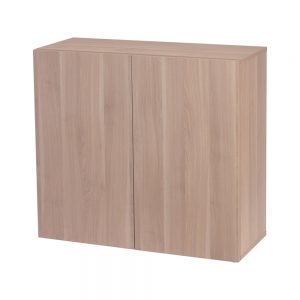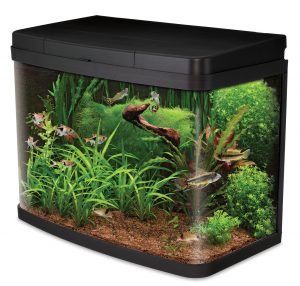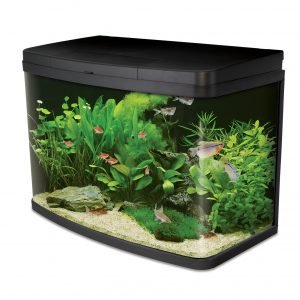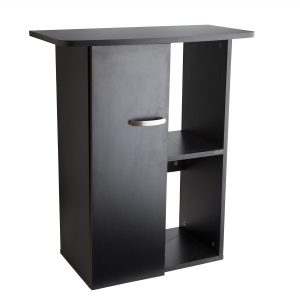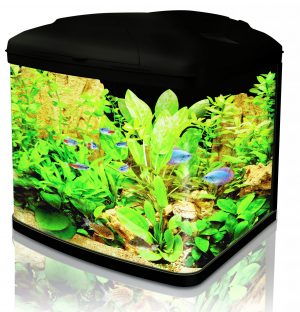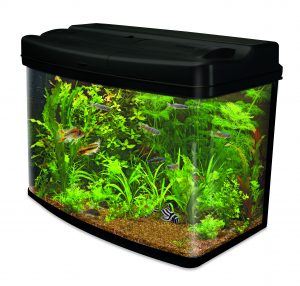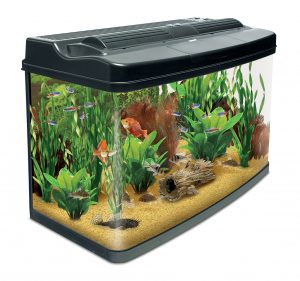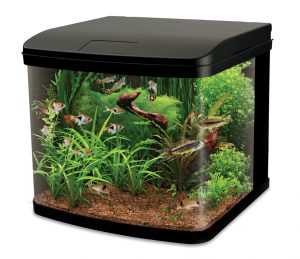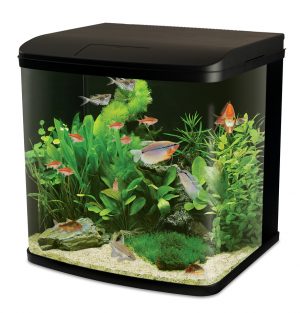Aquarium & Fish Tank FAQs
Looking to learn more about aquariums & fish tanks? Here are some of the most asked questions answered for you.
What are the different types of aquariums?
There are two main types of home aquariums:
- Coldwater aquariums – suitable for temperate fish species that do not require a heater to maintain the water temperature. For example, Zebrafish, White Cloud Mountain Minnow, and Endler’s. These fish can live happily in an aquarium with other compatible species.
- Freshwater tropical aquariums – For tropical fish species that require heated water to maintain their ideal temperature. Better suited for fish like Tetras, Rainbows, Guppies and Corydoras.
Which size aquarium is best?
When it comes to setting up your first aquarium, the recommended size should be no smaller than 20 Litres. However, a 60-litre aquarium or larger is ideal for first time fish owners.
This size provides enough room for your fish to swim around comfortably, while still allowing you to easily clean and maintain the tank. Plus, with this size, you can include some decorations and plants to create an even more naturalistic environment.
The larger the aquarium, the bigger the surface area. This also ensures better oxygenation, which is important for keeping your fish healthy. Too small of a tank may not provide enough space for your fish, while too large of a tank may be difficult to clean and maintain.
Learn more about choosing the right aquarium tank
Which colour fish tank is best?
When it comes to choosing the right colour, it all comes down to your preference and the type of fish you have. You may be looking for a specific style or design that blends well with your home.
For instance, if you are setting up a saltwater reef aquarium, then a blue background can help emphasise the vibrant colours of the fish and coral. Where as for freshwater fish tanks, a black or dark background is usually best, as it helps create a sense of depth in the tank.
What are the main types of fish tanks?
Rectangle and cube are the most common types of glass tanks. They provide an aesthetically pleasing view from all angles. Where as hexagonal tanks are great for smaller spaces, but come with their own set of challenges due to their odd shape.
If you want to maximise space in small areas and provide a unique viewing angle, then Corner aquariums are the way to go.
Do I need a heater for my fish tank over winter?
Aquarium heaters are essential for tropical fish or for temperate fish where the outside temperature drops below 18 degrees Celsius. Without a heater, the water temperature will drop too low, which can be dangerous for your fish.
This is especially important if you have tropical fish varieties that require temperatures above 22℃ to stay healthy. While the cost of a heater can add up, it’s worth it to keep your fish safe and comfortable.
How to maintain the ideal temperature in a fish tank
Temperatures can vary depending on the type of fish, but in general, most aquarium heaters come pre-set at 25℃ which is ideal.
To maintain this temperature, having the right size heater, with a filter and using an aquarium thermometer are essential. Be sure to monitor the tank on a regular basis to make sure everything is as it should be. If needed you can adjust the temperature setting where so.
Which fish tank is easiest to maintain?
In general, freshwater tanks are simpler to maintain and less risky than saltwater tanks. They are also more budget-friendly than saltwater setups. A freshwater tank can be made out of glass or acrylic and be any size.
Freshwater fish tanks are for fish species such as cichlids, betta fish, and tetras. In addition, when choosing a tank, look for one with a strong glass construction and reliable filters.
Do you have to change water in a fish tank?
Yes – this is because fish tanks are closed systems. This means the water doesn’t get replaced naturally like a body of water in nature. Therefore, regular water changes are needed, so that it remains clean and healthy.
The amount and frequency of water changes you need to do will depend on a few factors. But as a general rule of thumb, we would recommend doing a 20% water change every 28 days (once a month) with tap water conditioner.
How often should you clean your fish tank?
Most tanks should be cleaned about once every two weeks. Though this isn’t always the case for all tank, as some fish create more mess than others. There’s also what’s in your tanks – if you have a lot of decoration or live plants, they may require more cleaning.
There are also daily cleaning routines you can carry out to keep your tank in tip top shape.
Do you need an air pump for a fish tank?
Air pumps are a great way to increase oxygen levels in the water, which can be beneficial for most fish. However, they aren’t a requirement for all types of fish. For example, Betta fish don’t need an air pump as they have a labyrinth organ adapted to breathe gaseous air but they should still have a good filter.
If you’re unsure of what type of fish you have or how they might react to an air pump, speak to our experts for advice.
How long do you have to wait to put fish in a new tank?
Typically, you should wait at least 24 to 48 hours before adding fish to a new tank. Make sure to dose Fast Filter start, as it contains bacteria to kick start the waste breakdown process.
It’s essential to avoid the temptation to fully stock your aquarium for the first few months. Introduce fish gradually over several weeks to avoid issues.
Remember, it’s important to feed your fish very sparingly for the first 8 weeks whilst the nitrifying bacteria grow. This gives your fish enough time to acclimate to their new environment and ensures that all the set conditions for the ecosystem have had time to establish themselves.
You should also check the pH levels of your tank and make sure they are stabilised before adding any new fish. During this time, you can use an aquarium starter kit or water testing kit to monitor the water quality of your tank.
Should you turn your aquarium light off at night?
Yes – it is best to turn off the aquarium light at night, as most fish need a period of darkness in order to rest.
Too much light can cause stress to your fish, and can also lead to an increase in algae growth, which will make your tank look unsightly. If you would like some light in the room while they are resting, consider using a lighting controller.
Will my fish be OK in a small fish tank?
This mainly depends on the amount of fish you intend to have in your tank. If you plan on having multiple fish or larger species, a larger tank is recommended to ensure they have enough space to swim and thrive.
Fish that are too large or active for a small tank may become stressed, aggressive, or unhealthy. They may also produce higher levels of waste, leading to poor water quality. Research the specific needs of the fish you plan to keep and provide them with an appropriate environment.
Can I add a background for aquarium tank?
Adding a background to your aquarium tank can enhance the overall appearance of your tank and provide a more natural and aesthetically pleasing environment for your fish. Backgrounds can come in a variety of styles, from plain coloured backgrounds to scenic underwater landscapes.
Make sure the background is waterproof and made specifically for aquarium use. You can find backgrounds that adhere to the back of your tank with adhesive or ones that simply slide into place. Make sure to clean the back of your tank before applying the background to ensure a smooth process.
Which background colour is best for an aquarium?
For freshwater tanks with brightly coloured fish, a dark blue or black background can help accentuate their colours and make them stand out more in the tank. These colours can also create a calming and visually appealing backdrop.
If you have a planted tank with greenery, a dark green background can help create a more natural look and blend in with the plants. Backgrounds with underwater scenery or rocks can also add depth and texture to your tank.
Ultimately, it will depend on your personal preference and the design of your tank. Experiment with different options to see what works best for you and your fish.
For more information, see further questions regarding aquariums and fish tanks.

